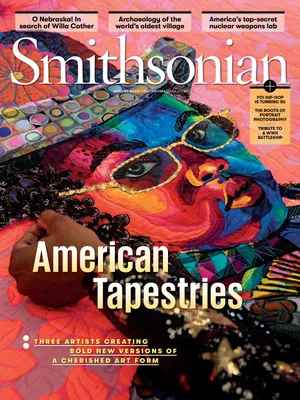See Inside One of America’s Last Pencil Factories
The family-owned facility in Tennessee produces more than 70 million pencils annually
:focal(2430x1527:2431x1528)/https://tf-cmsv2-smithsonianmag-media.s3.amazonaws.com/filer_public/de/b8/deb8b6a9-282a-492c-a1b6-e2924e5855d3/nmv09426.jpg)
Wood passes through the loud whine of saws spinning at 8,000 revolutions per minute. Pencils clack-clack-clack as they shoot through a paint box and assume their various hues. Next is the din of ratcheting as aluminum ferrules and erasers are punched onto ends. Now and then a blast of air clears the machinery’s crevices so the conveyor belts remain in constant, fluid motion.
/https://tf-cmsv2-smithsonianmag-media.s3.amazonaws.com/filer_public/21/19/2119fed4-5966-4a38-b4c3-5fed4c145a76/nmv00048.jpg)
But near the end of the assembly line, in a nook where pencils are imprinted with their logos, the sound is no more than the soft clink of the perfect little sticks falling into a heap. Scott Johnson plucks one from a bin and looks at the name freshly stamped in silvery foil.
“World’s smallest billboard,” he says.
/https://tf-cmsv2-smithsonianmag-media.s3.amazonaws.com/filer_public/e6/54/e6544c5d-2a87-4502-97f3-cbc4bb4d2818/julaug2023_g11_prologue.jpg)
And so it steadily goes at Musgrave Pencil Company, one of the few pencil manufacturers left in the United States—there are perhaps four, whereas there used to be some two dozen—and certainly the last in Shelbyville, Tennessee, about 60 miles south of Nashville, where the municipal seal bears the words “The Pencil City.”
/https://tf-cmsv2-smithsonianmag-media.s3.amazonaws.com/filer_public/d5/15/d515a400-943c-4ee9-b77c-dde50305ae51/nmv00379.jpg)
That reputation began with James Raford Musgrave, who founded a pencil-wood mill there in 1916. His and other milling operations were drawn to the area by its abundance of virgin eastern red cedars, the slow-growing premier pencil stock that the industry soon used up. Musgrave cut wood into the thin, flat slats that factories would sandwich around sticks of graphite, then slice into pencils. He began making his own pencils in 1923, launching what’s thought to be the first pencil manufacturer in the South. Soon, other manufacturers started arriving in Shelbyville and nearby towns.
/https://tf-cmsv2-smithsonianmag-media.s3.amazonaws.com/filer_public/4b/2b/4b2ba37e-5819-4d9c-b229-f338dff67475/nmv09900.jpg)
Today the family-owned business stands on the same spot where it began. Inside a two-story warehouse, unadorned but for a 25-foot-long No. 2 pencil painted on the outside, nearly 100 employees produce around 72 million pencils a year.
Johnson, 58, became president in November and is the fourth generation of the family to lead the business. (His wife, Ann Johnson, is James Musgrave’s great-granddaughter.) He joined in 2021, after a career in electrical engineering, and says the factory’s puzzles of precision and optimization appeal to him. He’s also watchful for new ways to do business, given the onslaught of less expensive imports. Last year the U.S. imported 3.7 billion pencils from China, Brazil and elsewhere.
/https://tf-cmsv2-smithsonianmag-media.s3.amazonaws.com/filer_public/4a/c4/4ac494e0-264a-45a9-8de1-c83ef79fbe0e/julaug2023_g06_prologue.jpg)
Pencil-making began in the U.S. around 1812, and early industry leaders included John Thoreau of Concord, Massachusetts, and his son Henry David, the great American activist and essayist. The late 19th century brought the ubiquitous yellow pencil—made in imitation of a posh European model of the day—and, a gift to wordsmiths to this day, the built-in eraser.
/https://tf-cmsv2-smithsonianmag-media.s3.amazonaws.com/filer_public/48/98/4898e2a1-b3bb-488a-bd4b-0a703c4bf24f/julaug2023_g05_prologue.jpg)
/https://tf-cmsv2-smithsonianmag-media.s3.amazonaws.com/filer_public/e2/5c/e25c4660-84ce-4ac2-84d1-7310f1057919/julaug2023_g07_prologue.jpg)
Musgrave has managed to escape history’s jaws, if not its grip: Most of the materials it once sourced locally or domestically now come from China. One thing it has done, taking advantage of the seemingly paradoxical forces of digital marketing and traditional artisan goods, is selling branded wares directly to the public, in addition to its longstanding business done mostly through wholesalers and distributors. Its roster of often decades-old Musgrave-branded pencil designs—from standard No. 2s to thicker carpenter pencils to the rotund Choo-Choo—has been gaining a reputation for quality and unstuffy craftsmanship among a new audience.
Caroline Weaver, an author of two books about pencils, who from 2014 to 2021 operated CW Pencil Enterprise, a New York City pencil boutique, says Musgrave pencils were popular in her shop. They appeal to “people who are serious pencil-users but aren’t really snobs about it,” she says. On top of being U.S.-made, “their stuff is affordable, it’s beautiful—it ticks all the boxes.”
/https://tf-cmsv2-smithsonianmag-media.s3.amazonaws.com/filer_public/c5/20/c5207538-2a78-4765-a6e2-50855931dfcf/nmv00604.jpg)
In 2019, after finding a new local source of eastern red cedar, Musgrave started selling its Tennessee Red, a naturally fragrant, marbled throwback to the early U.S. pencil industry and the hallowed wood that put Shelbyville on the map. Weaver calls it “the most American pencil that one could possibly buy.”
And those who do buy a box will find, when their package arrives, another timeless, uncommonly earnest artifact: a handwritten thank-you note, in pencil or pen.
